修辞学结课论文
- 格式:doc
- 大小:36.50 KB
- 文档页数:4
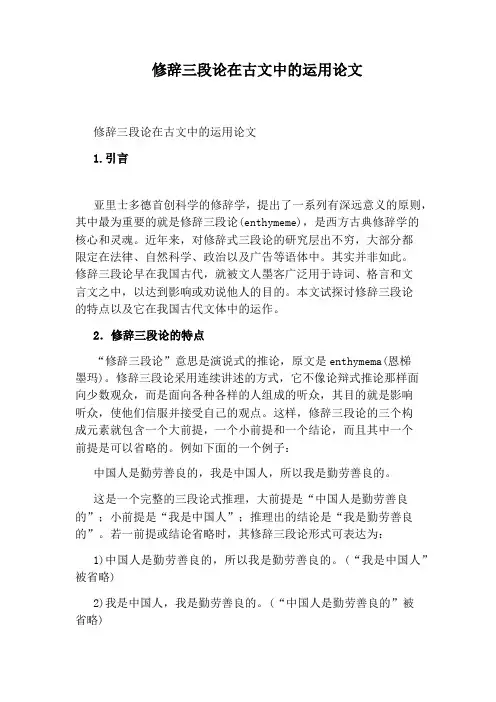
修辞三段论在古文中的运用论文修辞三段论在古文中的运用论文1.引言亚里士多德首创科学的修辞学,提出了一系列有深远意义的原则,其中最为重要的就是修辞三段论(enthymeme),是西方古典修辞学的核心和灵魂。
近年来,对修辞式三段论的研究层出不穷,大部分都限定在法律、自然科学、政治以及广告等语体中。
其实并非如此。
修辞三段论早在我国古代,就被文人墨客广泛用于诗词、格言和文言文之中,以达到影响或劝说他人的目的。
本文试探讨修辞三段论的特点以及它在我国古代文体中的运作。
2.修辞三段论的特点“修辞三段论”意思是演说式的推论,原文是enthymema(恩梯墨玛)。
修辞三段论采用连续讲述的方式,它不像论辩式推论那样面向少数观众,而是面向各种各样的人组成的听众,其目的就是影响听众,使他们信服并接受自己的观点。
这样,修辞三段论的三个构成元素就包含一个大前提,一个小前提和一个结论,而且其中一个前提是可以省略的。
例如下面的一个例子:中国人是勤劳善良的,我是中国人,所以我是勤劳善良的。
这是一个完整的三段论式推理,大前提是“中国人是勤劳善良的”;小前提是“我是中国人”;推理出的结论是“我是勤劳善良的”。
若一前提或结论省略时,其修辞三段论形式可表达为:1)中国人是勤劳善良的,所以我是勤劳善良的。
(“我是中国人”被省略)2)我是中国人,我是勤劳善良的。
(“中国人是勤劳善良的”被省略)3)中国人是勤劳善良的,我是中国人。
(“我是勤劳善良的”被省略)这表明,修辞三段论中的两个前提和结论可以省略其中的任何一个,通过剩下的两方来推理得出。
上述例证还表明修辞式推论的前提是属于人类行动范围的或然的事,所以根据这种前提推出的结论也是或然性的,这是修辞三段论和逻辑三段论的本质区别。
后者是基于必然性基础之上的,不生成知识。
其前提和结论早已经过论证存在一种必然的联系,所得出的结论不是新知识,而是人们公认的真理或事实。
但修辞三段论生成知识,因为它是在论辩的过程中形成的。

修辞手法在议论文中运用论文
修辞手法在议论文中的运用
议论文因为四平八稳,给不少学生一种错感,就是不必运用什么修辞手法。
其实恰当地运用修辞手法可以让文章如虎添翼,从而才能拿下高分甚至满分。
那么,可以在那些部分运用那些修辞手法呢?
一、开头、结尾部分
比喻,排比,对比,引用等
俗话说,好的开头是成功的一半,当然好的结尾也为文章画上圆满的句号。
所以训练议论文时,多花点时间训练开头结尾是必要的,其方法很多,而我常用的方法就是让学生经常运用比喻,排比,引用等修辞手法。
这三种修辞手法可以分别运用也可以合并运用,只为一个共同的目的。
且看下面的例子:
a对比结合排比写开头结尾:在真实与虚伪之间,我唾弃虚伪;在忠诚与背叛之间,我厌恶背叛;在宽容与狭隘之间.我保留宽容:在自尊与阿谀之间,我恪守尊严。
在成长的路上,有舍有得,心灵的选择决定了你一生的方向,心灵的选择是人的灵魂的集合。
上例选自优秀作品集中《心灵的选择》一文,文中将真实与虚伪,忠诚与背叛,宽容与狭隘,自尊与阿谀排列在一起,通过它们之间的正反对比,更好地表达了自己《心灵的选择》。
b比喻结合排比写开头结尾:感动好象暖暖的春风,“二月春风似剪刀”给大地带来春的消息,让世界充满生机和活力。
感动仿佛隐。

Rhetorical Functions of Accuracy and Vagueness Vagueness, clearly, is a matter of degree, depending upon the extent of the possible differences between different systems represented by the same representation. Accuracy, on the contrary, is an ideal limit.1Generally speaking, vagueness is a language attribute, so we should bear it in mind that accuracy as well as vagueness is a comparative definition. However, as two important ways of expression, they both possess rhetorical functions.First of all, accuracy enables a speaker or writer to express ideas exactly and to the point while vagueness allows him or her to carry on the communication smoothly.Speech and writing are always man’s important methods of communication, which requires people to convey information and ideas in the exact degree. In other words, accuracy ensures exact expression in communicative function. Hereafter is an example about the British General Churchill, who highly stressed accuracy. During the WWII, an officer working in Department of Chief of General Staff of the British Army once reported that his troop had been fighting with the Germans at a small village in Italy. Back came Churchill’s copy that “We do not fight with Germans. We fight either for or against them.”In this example, the officer had expected to convey the information of fighting against enemies but failed to express it exactly, which aroused ambiguity in meaning.Thought it’s of great importance to adhere to accuracy, when one finds it impossible to be accurate or suddenly is at a loss about expressing something in a exact way, he or she may resort to a vague term to carry on the communication smoothly.e.g. “Oh… in the trade somewhere round fifteen thousand dollars. But if it was bought on Fifth Avenue, I shouldn’t be surprised to hear that anything up to thirty thousand was paid it.”(W. Somerset Maugham, Mr. Know-All)In the example above, the expressions like “somewhere round”are vague 1Bertrand Russell, Vagueness, /~crshalizi/Russell/vagueness/, Oct.21 2007reference because the speaker can hardly tell how much and where.By doing so, he was able to let the topic move on in a smooth and natural way.Secondly, accuracy allows no ambiguity, so accurate expression is always grand and direct. On the other hand, vagueness can fulfill a useful function of tactful expression.e.g. “Could you do me a favor?”“Sorry, I simply can’t promise.”In this example, “simply can’t”shows the speaker’s straightforwardness and frankness about refusal. Thus accuracy here conveys his attitude directly towards the other’s request for help.As to the function of vagueness, when one finds it unnecessary or unwise to be very accurate, he or she may make deliberate use of vagueness. In this respect, what people call “tactful expression” are most commonly used.e.g. TV reporter: “Would you mind telling me frankly what do you think of our programs?”One of the audience: “Well, some are interesting, some could be better, and some are almost sort of rubbish.”In this dialogue, although the questioner was evidently trying to get some frank opinions, the answer was full of vague terms like “some…some…and some…”. The reason is that the person questioned didn’t want to hurt the reporter. Instead, he chose a tactful way of vagueness to show his opinion about the programs.Last but not least, accuracy features the function of persuasion while vagueness serves as a device for emphasis.e.g. “You’ll be surprised to hear that Mrs. Ramsay bought that string at a department store the day before we left New York for eighteen dollars.”(W. Somerset Maugham, Mr. Know-All)In this example, the expressions like “the day before we left New York” and “for eighteen dollars”are accurate and exact reference to numbers and time. These definite terms not only show the speaker’s confidence but also add convictive evidence to his speech. In other words, accuracy here strengthens the persuasive power of the speaker.Although vagueness usually blurs the idea, appropriate use of vague expression can help to emphasize expressions.e.g. ThanksThanks a million.In the example above, “a million”are the vague expression. Compared with “Thanks”, “Thanks a million” strongly emphasizes the degree of one’s appreciation. In a word, vague elements can be found in rhetorical figures of hyperbole and understatement to function as emphasis.In conclusion, accuracy focuses on exact, direct and persuasive conveyance of ideas, attitudes and argumentations. Then vagueness speaks highly of smoothness, tact and emphasis in expression and communication. Therefore, both accuracy and vagueness give full play to their functions in communicative rhetoric (exact, direct, smooth and tactful expressions) as well as in aesthetic rhetoric (persuasive power and figure of hyperbole).(注:文档可能无法思考全面,请浏览后下载,供参考。
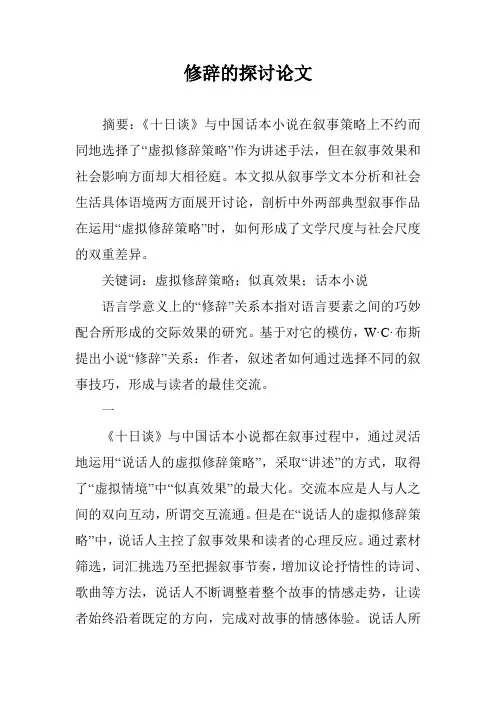
修辞的探讨论文摘要:《十日谈》与中国话本小说在叙事策略上不约而同地选择了“虚拟修辞策略”作为讲述手法,但在叙事效果和社会影响方面却大相径庭。
本文拟从叙事学文本分析和社会生活具体语境两方面展开讨论,剖析中外两部典型叙事作品在运用“虚拟修辞策略”时,如何形成了文学尺度与社会尺度的双重差异。
关键词:虚拟修辞策略;似真效果;话本小说语言学意义上的“修辞”关系本指对语言要素之间的巧妙配合所形成的交际效果的研究。
基于对它的模仿,W·C·布斯提出小说“修辞”关系:作者,叙述者如何通过选择不同的叙事技巧,形成与读者的最佳交流。
一《十日谈》与中国话本小说都在叙事过程中,通过灵活地运用“说话人的虚拟修辞策略”,采取“讲述”的方式,取得了“虚拟情境”中“似真效果”的最大化。
交流本应是人与人之间的双向互动,所谓交互流通。
但是在“说话人的虚拟修辞策略”中,说话人主控了叙事效果和读者的心理反应。
通过素材筛选,词汇挑选乃至把握叙事节奏,增加议论抒情性的诗词、歌曲等方法,说话人不断调整着整个故事的情感走势,让读者始终沿着既定的方向,完成对故事的情感体验。
说话人所希望达到的效果,不是众说纷纭,见仁见智的喧嚷,而是听众对故事主题绝对的一致性认同。
翻开《十日谈》,我们看到:讲述者们在慢慢摸索出使讲述得以规范化的方式:每天固定一个主题,故事围绕主题展开,形成一个集中、凝练的系列。
不论薄迦丘的创作意图是否有此一项,这种结构安排在客观的阅读效果上造成了“你中有我,我中有你”的文本间交流,也就是说,在戏剧的大幕拉开之前,演员们已经互为观众,评点对方了。
此种叙事结构让同一主题在不同的叙述者口中重现并被不断强化;与此同时,每当故事告一段落,现场听众的反应都被记录下来。
在第一天第4个故事中,第奥纽讲述了“小修士犯色戒,却施巧计逃脱修道院长的责罚”的故事。
结果“小姐们听着第奥纽的故事,起初很有些儿难为情,脸儿都不觉红了起来;她们你看看我,我望望你,终于忍不住了。
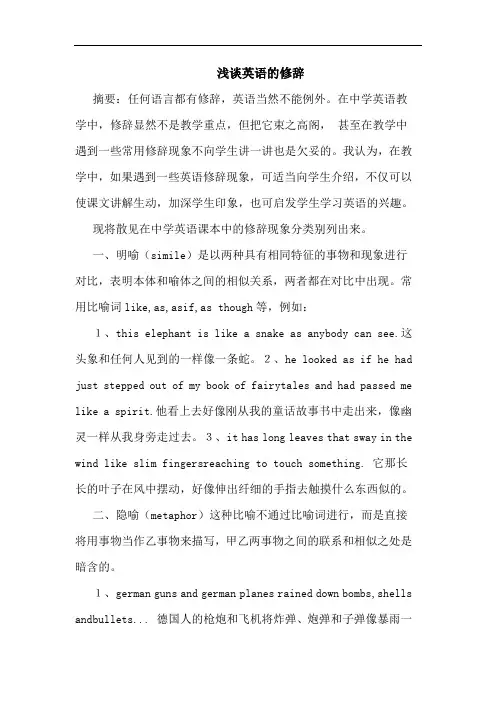
浅谈英语的修辞摘要:任何语言都有修辞,英语当然不能例外。
在中学英语教学中,修辞显然不是教学重点,但把它束之高阁,甚至在教学中遇到一些常用修辞现象不向学生讲一讲也是欠妥的。
我认为,在教学中,如果遇到一些英语修辞现象,可适当向学生介绍,不仅可以使课文讲解生动,加深学生印象,也可启发学生学习英语的兴趣。
现将散见在中学英语课本中的修辞现象分类别列出来。
一、明喻(simile)是以两种具有相同特征的事物和现象进行对比,表明本体和喻体之间的相似关系,两者都在对比中出现。
常用比喻词like,as,asif,as though等,例如:1、this elephant is like a snake as anybody can see.这头象和任何人见到的一样像一条蛇。
2、he looked as if he had just stepped out of my book of fairytales and had passed me like a spirit.他看上去好像刚从我的童话故事书中走出来,像幽灵一样从我身旁走过去。
3、it has long leaves that sway in the wind like slim fingersreaching to touch something. 它那长长的叶子在风中摆动,好像伸出纤细的手指去触摸什么东西似的。
二、隐喻(metaphor)这种比喻不通过比喻词进行,而是直接将用事物当作乙事物来描写,甲乙两事物之间的联系和相似之处是暗含的。
1、german guns and german planes rained down bombs,shells andbullets... 德国人的枪炮和飞机将炸弹、炮弹和子弹像暴雨一样倾泻下来。
2、the diamond department was the heart and center of the store.钻石部是商店的心脏和核心。
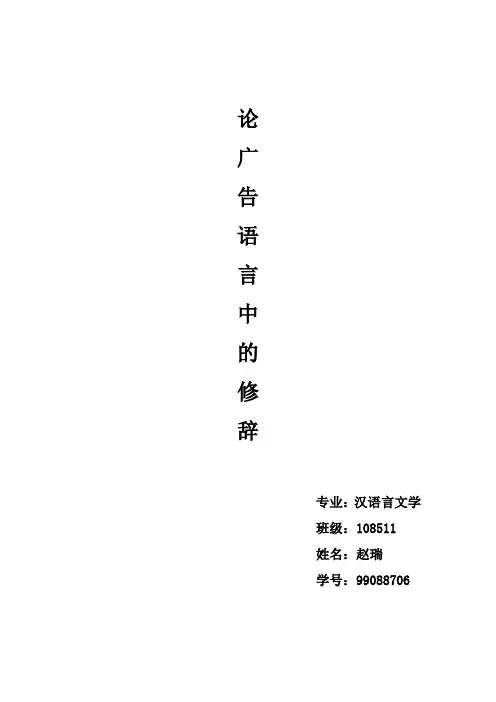
论广告语言中的修辞专业:汉语言文学班级:108511姓名:***学号:********论广告语言中的修辞摘要:广告语修辞对消费者心理的影响广告自诞生之日起便具有了强烈的功利性,它是一门浓缩的、综合的艺术。
修辞是一种个性化、意图化的认知方式,广告修辞将这一意图直接指向商品本身。
广告修辞的过程是使消费者对品牌产生认同的过程。
这个过程是一个双向过程,既有解读广告中受众对广告话语的认知也有构建广告的广告人对受众的劝说。
广告作为一种功利性的传播活动必然追求效果,希望消费者购买。
广告修辞不但使消费者更形象地感知产品的特性,还在消费者对品牌认同、消费引导等方面产生重要作用。
关键词:修辞手法,广告,广告效应一、当前的信息时代,五光十色千姿百态的广告令人目不暇接。
然而,广告真正吸引人们注意力的除了其色彩、画面、音乐等因素外,更重要的是广告语,它是广告的灵魂所在。
作为广告的重要载体——广告语,在传达广告的内容时,主要通过丰富多彩的修辞,来宣传商品,吸引人们的注意力,激起人们强烈的购买欲望。
修辞是语言的艺术化,它是指用各种表现手法对文字语句积极地进行调整和修饰,以使语言表达更准确、鲜明、生动而有力,是提高语言表达效果的一种手法。
在现代广告中,运用修辞对广告语进行创意,一方面能准确无误地传达商品的特点,实现广告的信息功能;另一方面,吸引受众的注意力,进而给受众以启示和联想,在相当短的时间内缩短商品生产者、销售者和受众之间的距离,激起受众强烈的购买欲望,产生预期的广告效应。
二、广告语中经常使用的修辞技法1、比喻比喻是利用事物的相似点,通过打比方来使某一事物更形象生动,更有感染力、说服力的一种修辞方式。
这种修辞格契合了广告语要在很短的时间内传达完美信息的特性,使人产生深刻的印象。
秦牧说:“精致的比喻就像童话中的魔棒,碰到哪儿,哪儿就发出奇特的变化。
”它可以把深奥的道理说得浅显易懂,可以将抽象的事物进行形象的表现,可以把陌生的概念变成熟悉的事物,可以将平淡表现为生动。

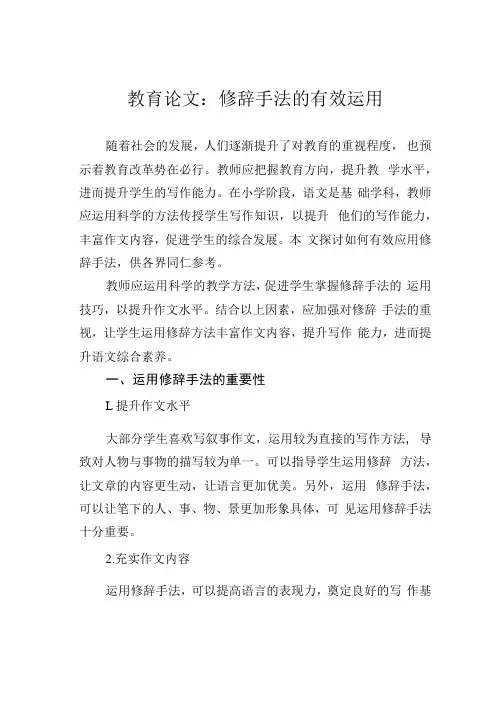
教育论文:修辞手法的有效运用随着社会的发展,人们逐渐提升了对教育的重视程度,也预示着教育改革势在必行。
教师应把握教育方向,提升教学水平,进而提升学生的写作能力。
在小学阶段,语文是基础学科,教师应运用科学的方法传授学生写作知识,以提升他们的写作能力,丰富作文内容,促进学生的综合发展。
本文探讨如何有效应用修辞手法,供各界同仁参考。
教师应运用科学的教学方法,促进学生掌握修辞手法的运用技巧,以提升作文水平。
结合以上因素,应加强对修辞手法的重视,让学生运用修辞方法丰富作文内容,提升写作能力,进而提升语文综合素养。
一、运用修辞手法的重要性L提升作文水平大部分学生喜欢写叙事作文,运用较为直接的写作方法, 导致对人物与事物的描写较为单一。
可以指导学生运用修辞方法,让文章的内容更生动,让语言更加优美。
另外,运用修辞手法,可以让笔下的人、事、物、景更加形象具体,可见运用修辞手法十分重要。
2.充实作文内容运用修辞手法,可以提高语言的表现力,奠定良好的写作基础。
善用修辞方法,不仅能提升作文水平,还可以丰富作文内容,促进学生的全面发展。
二、修辞手法的种类1.比喻修辞修辞手法较多,其中比喻修辞是较为常见的,比喻修辞是借助两个相似的事物,用跟甲事物有相似之处的乙事物描写或说明甲事物,一般比较直接,以让读者更好地理解,增加文章的韵味。
教师一般在讲解比喻修辞时,会用理论讲解的方式,并分析其是否是比喻修辞,然后开始讲解应该如何运用,以加深学生对比喻修辞的认识。
例如,教学《美丽的小兴安岭》,教师可指导学生思考如果自己写要如何描写小兴安岭一年四季的景色。
很多同学认为应该针对小兴安岭的四季特点分别进行叙述,内容大概为“温暖的春季、炎热的夏季、凉爽的秋季、寒冷的冬季”,可以看出大部分学生运用修辞能力较弱。
因此,教师可在教学中融入比喻修辞。
例如,可以针对小兴安岭的四季景色,运用比喻修辞,“小兴安岭四季的景色十分诱人,如同一座美丽的花园”,教师可指导学生学习运用比喻修辞,并思考作者把小兴安岭的景色比喻成花园的好处,系统地讲解比喻修辞,加深学生对比喻修辞的理解,并学会运用比喻修辞描写事物。
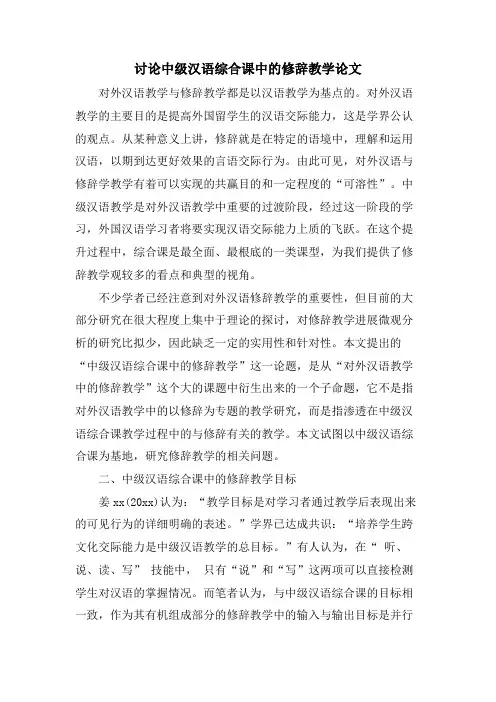
讨论中级汉语综合课中的修辞教学论文对外汉语教学与修辞教学都是以汉语教学为基点的。
对外汉语教学的主要目的是提高外国留学生的汉语交际能力,这是学界公认的观点。
从某种意义上讲,修辞就是在特定的语境中,理解和运用汉语,以期到达更好效果的言语交际行为。
由此可见,对外汉语与修辞学教学有着可以实现的共赢目的和一定程度的“可溶性”。
中级汉语教学是对外汉语教学中重要的过渡阶段,经过这一阶段的学习,外国汉语学习者将要实现汉语交际能力上质的飞跃。
在这个提升过程中,综合课是最全面、最根底的一类课型,为我们提供了修辞教学观较多的看点和典型的视角。
不少学者已经注意到对外汉语修辞教学的重要性,但目前的大部分研究在很大程度上集中于理论的探讨,对修辞教学进展微观分析的研究比拟少,因此缺乏一定的实用性和针对性。
本文提出的“中级汉语综合课中的修辞教学”这一论题,是从“对外汉语教学中的修辞教学”这个大的课题中衍生出来的一个子命题,它不是指对外汉语教学中的以修辞为专题的教学研究,而是指渗透在中级汉语综合课教学过程中的与修辞有关的教学。
本文试图以中级汉语综合课为基地,研究修辞教学的相关问题。
二、中级汉语综合课中的修辞教学目标姜xx(20xx)认为:“教学目标是对学习者通过教学后表现出来的可见行为的详细明确的表述。
”学界已达成共识:“培养学生跨文化交际能力是中级汉语教学的总目标。
”有人认为,在“ 听、说、读、写” 技能中,只有“说”和“写”这两项可以直接检测学生对汉语的掌握情况。
而笔者认为,与中级汉语综合课的目标相一致,作为其有机组成部分的修辞教学中的输入与输出目标是并行不悖的,具有同等的重要性。
因此,中级汉语综合课中的修辞教学目标可以做如下表述:1.通过对重点词语和语言点的学习,了解文本的内容,能进展词语扩展、完成句子或答复与课文有关的问题。
2.在明确课文的语体类型的根底上,领会词语的语体特点。
3.理解课文中的文化元素,逐步完善并稳固自身的文化知识系统。
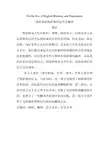
浅论英语修辞格的运用及翻译摘要修辞格是人们在组织,调整,修饰语言,以提高语言表达效果的过程中长期形成的具有特定结构,特定方法,特定功能,为社会所公认的言语模式。
无论在文学作品还是日常生活中,我们都力求运用生动形象鲜明准确的语言有效地表达思想感情,因而有必要学习和研究修辞格的翻译,从而我们会更好的运用语言,阅读和欣赏文学作品,以提高我们的语言文化修养。
本文主要有三部分组成。
在第一部分,作者主要介绍了修辞格的定义,与此同时,这一部分也阐明了修辞格的作用和范围,因此我们可以更好地理解修辞格。
第二部分,文章介绍了由于语言和文化差异,导致了英汉修辞格翻译的不同,也指出了一些翻译者需要注意的问题。
第三部分主要介绍了几种修辞格和它们相应的翻译方法。
关键词:修辞;翻译;语言差异;文化差异ABSTRACTRhetoric is a speech pattern which comes into being in the long-term process of organizing,regulating languages to improve the effectiveness of expression.Rhetoric is approved socially and has its definite structures,techniques and functions.Whether it is in the field of literary works or daily life,we all try our best to express our emotions and feelings effectively by using vivid,lively ang exact languages.Therefore,it is necessary to learn and study the translation of rhetoric so that we could better use language,read and appreciate literary works. Finally,we could improve our cultural refreshment.This paper consists of three parts. In the first part,the author mainly introduces the definition of rhetoric.At the same time,this part also elaborates the scope and function of rhetoric so that we could better understand the rhetoric.In the second part,this paper displays that the rhetorical translation of Chinese and English is different owing to the difference between different languages and cultures.It also points out some problems which translators should pay attention to in the process of translating.The third part mainly displays a few rhetoric and their corresponding translation techniques.Key words:rhetorical device;translation;language difference;Cultural differenceContents摘要ABSTRACTContentsIntroduction1.Rhetoric1.1 Definition of Rhetoric1.2 Modern Rhetoric:Its Scope and Functions1.3 Rhetoric:Its Role in Translation2.Differences between English and Chinese Rhetoric and Their Translation2.1 language Differences and Translation2.1.1 Phonetic Form and Text Patterns2.1.2 V ocabulary Morphology2.1.3 Syntactic Structure2.2 Cultural Differences and Translation2.2.1 The Material Culture2.2.2 Institutional Culture2.2.3 Psychological Culture3.Specific Translation Methods of Rhetocics3.1 Metaphor and Its Translation3.1.1 Simile and Its Translation3.1.2 Metaphor and Its Translation3.2 Metonymy and Its Translation3.3 Parallel Structures and Its Translation 3.4 Personification and Its Translation 3.5 Other Rhetoric3.5.1 Hyperbole3.5.2 Transferred Epithet3.5.3 AlliterationConclusionBibliographyAcknowledgementIntroductionOriginating from 2000 years ago,the ancient Greece,rhetoric is a subject of language arts.Rhetoric is the art of using language,and is seen as the decoration of the languages like icing on the cake.Whether in literature or in daily life people have always sought out the use of vivid,clear,precise language to express their feelings.Therefore,it is necessary to study and research the figure of speech and its translation in order to use languages,read and appreciate literary works as well as to improve our culture refreshment. In translation,we can neither correctly express the original's thoughts,spirits and its styles nor weaken the original without right reflection of figure of speech.Rhetoric in Translation is a huge issue,therefore,people properly handling the translation of the rhetoric is necessary.The relationship between translation and rhetoric are very close.A translator should understand the rhetorical techniques of the source,and make use of rhetorical devices in order to reproduce faithfully and effectively the content,intention,feeling and style of the original text.This paper firstly generalizes thesituation of the study about the rhetoric in the home or foreign from the function and the field of rhetoric.From the comparison of English and Chinese rhetorics,the paper further explains the same and difference of the two kinds of rhetorics because of the languages and cultures.Finally,this paper briefly elaborates how to understand and translate the English rhetoric on the basis of being loyal for the text.This paper consists of three parts.In the first part,author gives the general definition of rhetoric,so that we can have a clear understanding of rhetoric.Also,in this part,we probe into the functions and scope of rhetoric.All in all,in the first part, the author gives some basic knowledge of rhetoric and the relationship between rhetoric and translation.In the second part,this thesis introduces readers some basic knowledge of rhetorical translation.Also,the author displays things that translator should pay attention to in his work.In the third part,this paper probes deep into the relationship between rhetoric and translation.1.Rhetoric1.1 Definition of RhetoricRhetoric originates in speech in the West.Aristotle,in the 4th century BC,first defined rhetoric,which has contributed to its flourishing in the academic field.With the development and influence of modern linguistics,philosophy,semantics, psychology,etc,great success has been achieved in rhetoric studies whether basic conception or specific problem.Since 1950,modern rhetoric,especially Anglo-American modern rhetoric,has developed into a large discipline involving practical rhetoric,rhetoric in argumentation,rhetoric of fiction,stylistics,etc.格式!!!Hence rhetoric is endowed with new meanings.1.2 Modern Rhetoric:Its Scope and FunctionsModern rhetoric is a large field,too large to be plotted here.According to H.Hudson(1990),rhetoric includes both oral rhetoric and literary rhetoric."注明出处Oral rhetoric focuses on the wielders of public opinion while literal rhetoric emphasizes aesthetic analysis"(Hudson.1990).A modern discussion usually consists of chapters on diction,figure of speech,and forms ofarrangement,such as antithesis,periodicity and balance.The identification of rhetoric only with persuasion in the West and with ornament of writing in China seems to have vanished.In the eye of a rhetorician,any linguistic symbol has a rhetorical meaning in a specific situation.Rhetoric,however,as a serious scholarly study,has entered a wider area.That there is a body of philosophy and principle worth scholarly effort in discovery,enlargement,and reinterpretation is beyond question,and fortunately more competent scholars each year are working at it.Rhetorical criticism and the study of rhetoric as a revealing social and cultural phenomenon are also gaining ground.New and interesting directions for studies in these areas are being explored,or at least marked out;they are based on newly developed techniques.Text linguistics,for example,is a newly-developed discipline,out of which textual analysis has developed.An analysis of any language symbol must be based on a specific text.No doubt,therefore,textual analysis will have more and more to contribute to modern rhetoric.Likewise,modern rhetoric has been applied to translation studies,which has developed to be a branch of rhetoric---translative rhetoric.There are many other researchtopics,e.g,rhetoric in discourse,psycho-rhetoric,contrastive rhetoric,pragmatic rhetoric,textual rhetoric,interpersonal rhetoric,rhetoric in journalism,etc.No doubt,these new disciplines on rhetoric will definitely widen and enrich the scope of rhetoric studies.词的间距!!Now turn to the point of rhetorical functions.Generally speaking,the rhetorical function,in present-day usage,is the function of adjusting words or sentences suitable to a discourse situation.According to Bryant(1990)."The rhetorical function is the function of adjusting ideas to people and of people to ideas."More specifically,the major function of rhetoric include wholeness,aesthetic appeal,impact,appropriateness, coherence,cohesion,focus and emphasis.According to different effects produced by these functions in a text,they are subdivided into communicative and aesthetic municative function ensures the choice of words and phrases,and selection of sentence patterns,organizing paragraphs and whole pieces of writing in such a way that ideas are expressed most clearly,most accurately and most appropriately and the intended results are achieved in municative function includes such matters as wholeness,unity,appropriateness,coherence,and cohesion.Aesthetic function creates the vividness andgracefulness in emotional appeal of one's speech or writing.Aesthetic appeal,impact and emphasis belong to aesthetic function.In fact,any literary text contains a combination of communicative rhetoric and aesthetic rhetoric.Both of them are effective means in communication and are often mingled and permeated with each other.Take the following sentences as an example:(1) I trembled,and turned white.Something…I don't know what or how…connected with the grave in the Churchyard,and the raising of the dead,seemed to strike me like an unwholesome wind(Dickens,92)This is a description of how little David was feeling at the news that he had got a new father.When he was told about it,he ‘trembled and turned white’to describe his feelings at the moment.Dickens appropriately chooses the indefinite pronoun ‘something’and a simile ‘strike me like an unwholesome wind,’which aims at exerting an emotional impact on the readers.1.3 Rhetoric:Its Role in TranslationRhetoric always plays an important role in the process of translation.As we know,the process includes two stages:comprehension and reproduction.The former is theprerequisite for and the beginning of the latter while the latter is the objective and outcome of the former.Inaccurate comprehension of the original will inevitably result in inaccurate reproduction.In some cases,we cannot puzzle out the meaning in reading the original while there are neither new words nor grammatical problems.We just can not make out the true essence of the diction though we check up various dictionaries of idiomatic usages may not help.Why?The obstacles most probably are rhetorical techniques employed in it.Indeed,a translator can hardly understand the original without knowledge of rhetorical techniques.For example:(2) Ham Peggotty,who went to the national school and was a very dragon at his catechism and who may therefore be regarded as a credible witness,reported next day,what happening to peep in at the parlour-door an hour after this…(Dicken,59)Ham Peggotty is likened to dragon,which means that he worked at his catechism as hard as a dragon safeguards his treasure.We may well be puzzled if we do not know about the metaphor.The importance of rhetoric lies not only in comprehending the source text,also in reproducing it.An ideal translation,especially literary translation,not only conveys thecontent of the source text,but reproduces aesthetic or artist charm of the source text.The purpose of rhetoric is to make the translation more effective and more adequate.(3)It haunted me n when I got home.I seemed to have left the Doctor's roof with a dark cloud lowering on it.The reverence that I had for his grey head was mingled with commiseration for his faith in those who were treacherous to him and with resentment against those who injured him(Dickens.339) 【Version 1】在我回家以后,这表情萦绕在我的心目中,我觉得我离开博士的屋顶时,那上面似乎有一层黑云笼罩着,我对他那白发的头所怀抱的敬意中,混有对他寄托在背叛他的人们身上的信心所抱的怜悯,以及对那些伤害他的人的愤慨(Tr.Dong327)【Version 2】在我离开那所房子的时候,好像那所房子上面有一片乌云,阴惨惨地笼罩。

浅论英语修辞格的运用及翻译摘要修辞格是人们在组织,调整,修饰语言,以提高语言表达效果的过程中长期形成的具有特定结构,特定方法,特定功能,为社会所公认的言语模式。
无论在文学作品还是日常生活中,我们都力求运用生动形象鲜明准确的语言有效地表达思想感情,因而有必要学习和研究修辞格的翻译,从而我们会更好的运用语言,阅读和欣赏文学作品,以提高我们的语言文化修养。
本文主要有三部分组成。
在第一部分,作者主要介绍了修辞格的定义,与此同时,这一部分也阐明了修辞格的作用和范围,因此我们可以更好地理解修辞格。
第二部分,文章介绍了由于语言和文化差异,导致了英汉修辞格翻译的不同,也指出了一些翻译者需要注意的问题。
第三部分主要介绍了几种修辞格和它们相应的翻译方法。
关键词:修辞;翻译;语言差异;文化差异ABSTRACTRhetoric is a speech pattern which comes into being in the long-term process of organizing,regulating languages to improve the effectiveness of expression.Rhetoric is approved socially and has its definite structures,techniques and functions.Whether it is in the field of literary works or daily life,we all try our best to express our emotions and feelings effectively by using vivid,lively ang exact languages.Therefore,it is necessary to learn and study the translation of rhetoric so that we could better use language,read and appreciate literary works. Finally,we could improve our cultural refreshment.This paper consists of three parts. In the first part,the author mainly introduces the definition of rhetoric.At the same time,this part also elaborates the scope and function of rhetoric so that we could better understand the rhetoric.In the second part,this paper displays that the rhetorical translation of Chinese and English is different owing to the difference between different languages and cultures.It also points out some problems which translators should pay attention to in the process of translating.The third part mainly displays a few rhetoric and their corresponding translation techniques.Key words:rhetorical device;translation;language difference;Cultural differenceContents摘要ABSTRACTContentsIntroduction1.Rhetoric1.1 Definition of Rhetoric1.2 Modern Rhetoric:Its Scope and Functions1.3 Rhetoric:Its Role in Translation2.Differences between English and Chinese Rhetoric and Their Translation2.1 language Differences and Translation2.1.1 Phonetic Form and Text Patterns2.1.2 V ocabulary Morphology2.1.3 Syntactic Structure2.2 Cultural Differences and Translation2.2.1 The Material Culture2.2.2 Institutional Culture2.2.3 Psychological Culture3.Specific Translation Methods of Rhetocics3.1 Metaphor and Its Translation3.1.1 Simile and Its Translation3.1.2 Metaphor and Its Translation3.2 Metonymy and Its Translation3.3 Parallel Structures and Its Translation 3.4 Personification and Its Translation 3.5 Other Rhetoric3.5.1 Hyperbole3.5.2 Transferred Epithet3.5.3 AlliterationConclusionBibliographyAcknowledgementIntroductionOriginating from 2000 years ago,the ancient Greece,rhetoric is a subject of language arts.Rhetoric is the art of using language,and is seen as the decoration of the languages like icing on the cake.Whether in literature or in daily life people have always sought out the use of vivid,clear,precise language to express their feelings.Therefore,it is necessary to study and research the figure of speech and its translation in order to use languages,read and appreciate literary works as well as to improve our culture refreshment. In translation,we can neither correctly express the original's thoughts,spirits and its styles nor weaken the original without right reflection of figure of speech.Rhetoric in Translation is a huge issue,therefore,people properly handling the translation of the rhetoric is necessary.The relationship between translation and rhetoric are very close.A translator should understand the rhetorical techniques of the source,and make use of rhetorical devices in order to reproduce faithfully and effectively the content,intention,feeling and style of the original text.This paper firstly generalizes thesituation of the study about the rhetoric in the home or foreign from the function and the field of rhetoric.From the comparison of English and Chinese rhetorics,the paper further explains the same and difference of the two kinds of rhetorics because of the languages and cultures.Finally,this paper briefly elaborates how to understand and translate the English rhetoric on the basis of being loyal for the text.This paper consists of three parts.In the first part,author gives the general definition of rhetoric,so that we can have a clear understanding of rhetoric.Also,in this part,we probe into the functions and scope of rhetoric.All in all,in the first part, the author gives some basic knowledge of rhetoric and the relationship between rhetoric and translation.In the second part,this thesis introduces readers some basic knowledge of rhetorical translation.Also,the author displays things that translator should pay attention to in his work.In the third part,this paper probes deep into the relationship between rhetoric and translation.1.Rhetoric1.1 Definition of RhetoricRhetoric originates in speech in the West.Aristotle,in the 4th century BC,first defined rhetoric,which has contributed to its flourishing in the academic field.With the development and influence of modern linguistics,philosophy,semantics, psychology,etc,great success has been achieved in rhetoric studies whether basic conception or specific problem.Since 1950,modern rhetoric,especially Anglo-American modern rhetoric,has developed into a large discipline involving practical rhetoric,rhetoric in argumentation,rhetoric of fiction,stylistics,etc.格式!!!Hence rhetoric is endowed with new meanings.1.2 Modern Rhetoric:Its Scope and FunctionsModern rhetoric is a large field,too large to be plotted here.According to H.Hudson(1990),rhetoric includes both oral rhetoric and literary rhetoric."注明出处Oral rhetoric focuses on the wielders of public opinion while literal rhetoric emphasizes aesthetic analysis"(Hudson.1990).A modern discussion usually consists of chapters on diction,figure of speech,and forms ofarrangement,such as antithesis,periodicity and balance.The identification of rhetoric only with persuasion in the West and with ornament of writing in China seems to have vanished.In the eye of a rhetorician,any linguistic symbol has a rhetorical meaning in a specific situation.Rhetoric,however,as a serious scholarly study,has entered a wider area.That there is a body of philosophy and principle worth scholarly effort in discovery,enlargement,and reinterpretation is beyond question,and fortunately more competent scholars each year are working at it.Rhetorical criticism and the study of rhetoric as a revealing social and cultural phenomenon are also gaining ground.New and interesting directions for studies in these areas are being explored,or at least marked out;they are based on newly developed techniques.Text linguistics,for example,is a newly-developed discipline,out of which textual analysis has developed.An analysis of any language symbol must be based on a specific text.No doubt,therefore,textual analysis will have more and more to contribute to modern rhetoric.Likewise,modern rhetoric has been applied to translation studies,which has developed to be a branch of rhetoric---translative rhetoric.There are many other researchtopics,e.g,rhetoric in discourse,psycho-rhetoric,contrastive rhetoric,pragmatic rhetoric,textual rhetoric,interpersonal rhetoric,rhetoric in journalism,etc.No doubt,these new disciplines on rhetoric will definitely widen and enrich the scope of rhetoric studies.词的间距!!Now turn to the point of rhetorical functions.Generally speaking,the rhetorical function,in present-day usage,is the function of adjusting words or sentences suitable to a discourse situation.According to Bryant(1990)."The rhetorical function is the function of adjusting ideas to people and of people to ideas."More specifically,the major function of rhetoric include wholeness,aesthetic appeal,impact,appropriateness, coherence,cohesion,focus and emphasis.According to different effects produced by these functions in a text,they are subdivided into communicative and aesthetic municative function ensures the choice of words and phrases,and selection of sentence patterns,organizing paragraphs and whole pieces of writing in such a way that ideas are expressed most clearly,most accurately and most appropriately and the intended results are achieved in municative function includes such matters as wholeness,unity,appropriateness,coherence,and cohesion.Aesthetic function creates the vividness andgracefulness in emotional appeal of one's speech or writing.Aesthetic appeal,impact and emphasis belong to aesthetic function.In fact,any literary text contains a combination of communicative rhetoric and aesthetic rhetoric.Both of them are effective means in communication and are often mingled and permeated with each other.Take the following sentences as an example:(1) I trembled,and turned white.Something…I don't know what or how…connected with the grave in the Churchyard,and the raising of the dead,seemed to strike me like an unwholesome wind(Dickens,92)This is a description of how little David was feeling at the news that he had got a new father.When he was told about it,he ‘trembled and turned white’to describe his feelings at the moment.Dickens appropriately chooses the indefinite pronoun ‘something’and a simile ‘strike me like an unwholesome wind,’which aims at exerting an emotional impact on the readers.1.3 Rhetoric:Its Role in TranslationRhetoric always plays an important role in the process of translation.As we know,the process includes two stages:comprehension and reproduction.The former is theprerequisite for and the beginning of the latter while the latter is the objective and outcome of the former.Inaccurate comprehension of the original will inevitably result in inaccurate reproduction.In some cases,we cannot puzzle out the meaning in reading the original while there are neither new words nor grammatical problems.We just can not make out the true essence of the diction though we check up various dictionaries of idiomatic usages may not help.Why?The obstacles most probably are rhetorical techniques employed in it.Indeed,a translator can hardly understand the original without knowledge of rhetorical techniques.For example:(2) Ham Peggotty,who went to the national school and was a very dragon at his catechism and who may therefore be regarded as a credible witness,reported next day,what happening to peep in at the parlour-door an hour after this…(Dicken,59)Ham Peggotty is likened to dragon,which means that he worked at his catechism as hard as a dragon safeguards his treasure.We may well be puzzled if we do not know about the metaphor.The importance of rhetoric lies not only in comprehending the source text,also in reproducing it.An ideal translation,especially literary translation,not only conveys thecontent of the source text,but reproduces aesthetic or artist charm of the source text.The purpose of rhetoric is to make the translation more effective and more adequate.(3)It haunted me n when I got home.I seemed to have left the Doctor's roof with a dark cloud lowering on it.The reverence that I had for his grey head was mingled with commiseration for his faith in those who were treacherous to him and with resentment against those who injured him(Dickens.339) 【Version 1】在我回家以后,这表情萦绕在我的心目中,我觉得我离开博士的屋顶时,那上面似乎有一层黑云笼罩着,我对他那白发的头所怀抱的敬意中,混有对他寄托在背叛他的人们身上的信心所抱的怜悯,以及对那些伤害他的人的愤慨(Tr.Dong327)【Version 2】在我离开那所房子的时候,好像那所房子上面有一片乌云,阴惨惨地笼罩。
谈话语中的修辞关联的生成方式关联原则,但在言语交际中,说话者与听话人既有利益一致、遵循最佳关联原则追求最佳关联的一面;也有出于不同交际目的,发话者或是诱导受话者定向、偏向关联,或是受话者有意违反最佳关联原则,进行多种关联,以期获得幽默、讽刺、新颖、雄辩等修辞效果,追求“最佳修辞效果关联” 的一面;而对言语交际中修辞关联的分析却正是关联理论研究所忽视的方面。
一、关联理论关联理论是Sperber和Wilson在《关联性:交际与认知》①中提出的一种语用学理论,它从认知的角度对话语理解进行了研究,是一种具有很本整理提供强解释力的交际与认知模式。
“关联理论首先把交际活动(包括言语交际和非言语交际)归属为认知活动,认为言语交际是一种有目的、有意图的活动;说话人的目的或意图能被听话人识别,是由于他们对认知环境(cognitive environment)具有共识;也就是说,交际是否成功,就看交际双方对彼此的认知环境是否能显映(manifest)和互相显映(mutually manifest)。
”②Sperber和Wilson 将关联定义为:“假设P同一系列语境假设之间的关系。
”(1991:381)他们认为,当且仅当一个假设在一定的语境中具有某一语境效果(contextual effect)时,这个假设在这个语境中才具有关联性(1986:122),并提出了最佳关联设想(Presumption of optimal relevance)和最佳关联原则(Principle of optimal relevance):(1)发话者意欲向听话人显映的假设集{I},具有足够的关联,使听话人值得努力去处理该明示的刺激信号(ostensive stimulus)。
(2)这一明示刺激信号,是发话者传递假设集{I}时所能运用的最大关联的信号。
(3)任何一个明示交际行为,必须保证自身的最大关联。
(1986:158)在关联理论中,Sperber和Wilson结合语码模式和推理模式,提出了明示推理交际(ostensive inferential communication)的概念,并将其定义为:说话人发出一种刺激信号,使之对交际双方互相显映(mutually manifest),通过这种刺激信号,说话人意欲向听话人显映或更加清楚地显映一系列的命题{I}(1986:63),只有说话人说出的话具有“明示性”,听话人的推理才有方向和目标,才能准确理解说话人话语的意义。
A Glimpse at the Figures of Speeches in Literary Works Group Members:Introduction:In this article, we find some examples about different figures of speeches in literary works. For the amount of literary works is very huge, we just find examples in masterpieces of writers, mainly Shakespeare’s writings.SimileA. Using “like”He was like a cock who thought the sun had risen to hear him crow.-George Eliot, Adam Bede B. Using “as”She dealt with moral problems as a cleaver deals with meat.-James Joyce, The Boarding House C. Without “as” or “like”Shall I compare thee to a summer's day? / Thou art more lovely and more temperate– William Shakespeare, Sonnet 18 Lear: … that she may feel/ How sharper than a serpent’s tooth it is/ To have a thankless child! Away, away!-William Shakespeare, King Lear So she shows she seems the budding rose, / Y et sweeter far than is earthly flower…-Robert Burns, A Red, Red Rose Clan in his nightshirt, his neck poked forward, his back rounded, he resembled some long white bird.-John Galsworthy, The Man of Property MetaphorA man may break a word with you, sir, and words are but wind.- William Shakespeare, The Comedy of Errors A boy’s will is the wind’s will, and the thoughts of youth are long, long thoughts.-Henry Wadsworth Longfellow, My Lost YouthAll the world’s a stage,/ And all the men and women merely players; / They have their exits and their entrances;-William Shakespeare, As Y ou Like ItA man may break a word with you, sir, and words are but wind.-William Shakespeare, The Comedy of Errors Time is a dressmaker specializing in alterations.-Faith Baldwin, Face Toward the Spring MetonymyFriends, Romans, Countrymen, lend me your ears.- William Shakespeare,Julius Caesar For never was a story of more woe, than this of Juliet and her Romeo- William Shakespeare, Romeo and Juliet SynecdocheI should have been a pair of ragged claws. /Scuttling across the floors of silent seas- T. S. Eliot, The Love Song of J. Alfred Prufrock Friends, Romans, Countrymen, lend me your ears.- William Shakespeare,Julius Caesar PersonificationIt murmurs and whispers still.The voice of that wayward song/ is singing and saying still.The music of that old song/Throbs in my memory still.The verse of that sweet old song, /it flutters and murmurs still.-Henry Wadsworth Longfellow, My Lost Youth See! The mountains kiss high heaven, and the waves clasp one another;-Percy Byshee Shelley, Love's Philosophy Thirsting flowers, in their noonday dreams, my wings, waken the sweet buds, their mother's breast, as she dances. –Percy Bysshe Shelley, The Cloud RepetitionThe rest of the evening was spent in conjecturing how soon he would return Mr. Bennet’s visit,and determining when they should ask him to dinner. In a few days Mr. Bingley returned Mr. Bennet’s visit, and sat about ten minutes with him in his library. “I do not believe a word of it,my dear. If he had been so very agreeable,he would have talked to Mrs. Long. But I can guess how it was; every body says that he is ate up with pride,and I dare say he had heard somehow that Mrs. Long does not keep a carriage,and had come to the ball in a hack chaise.”……“His pride,”said Miss Lucas,“does not offend me so much as pride often does,because there is an excuse for it.”……“That is very true,”replied Elizabeth,“and I could easily forgive his pride,if he had not mortified mine.”“Pride,”observed Mary,who piqued herself upon the solidity of her reflections,“is a very common failing I believe. By all that I have ever read,”……-Jane Austen, Pride and Prejudice EuphemismThus was I , sleeping , by a brother’s hand Of life , of crown , of queen , at once dispatch’d ;Cut off even in t he blossoms of my sin , Unhous’l ed , disappointed , unanel’d ;No reck’ning made , but sent to my account .With a ll my imperfectionon my head.-Williams. Shakespeare, HamletIs it not sufficient for you infernal selfishness, that while you a re at peace I shall writhe in it he torment s of hell?-Emily. Bronte, Wuthering Heights The pinched and meager aspect of the place would have killed a chameleon; he would have known, at the first mouthful, that t he air was notable, and must have given up the ghost in despair. –C. Dickens, The Old Curiosity Shop PunRomeo: Oh. She does teach the torches to bum bright! It seems she hangs upon the cheek of night like a rich jewel in an Ethiopia’s ear; Beauty too rich for use, for earth to dear!- William Shakespeare, Romeo and Juliet Lady M: If he do bleed. I will gild the faces of the grooms withal. For it must seem their guilt.- William Shakespeare, Macbeth Hyperbole"...O brawling love, O loving hate,anything, of nothing first create!heavy lightness, serious vanity,Misshapen chaos of well-seeming forms..."- William Shakespeare, Romeo and Juliet “What hands are here? ha! They pluck out mine eyes.Will all great Neptune's ocean wash this bloodClean from my hand? No, this my hand will ratherThe multitudinous seas in incarnadine,Making the green one red."- William Shakespeare, Macbeth "...he is sooner caught than the pestilence and the takerruns presently mad."- William Shakespeare, Much Ado About NothingClimaxRomeo: If I profane with my unworthiest handThis holy shrine, the gentle fine is this:My lips, two blushing pilgrims, ready standTo smooth that rough touch with a tender kiss.Juliet: Good pilgrim, you do wrong your hand too much,Which mannerly devotion shows in this;For saints have hands that pilgrims' hands do touch,And palm to palm is holy palmers' kiss.-William Shakespeare, Romeo and Juliet Oxymoron'O brawling love! O loving hate! . . .O heavy lightness! serious vanity!Misshapen chaos of well-seeming forms!Feather of lead, bright smoke, cold fire, sick health!Still-waking sleep, that is not what it is!This love feel I, that feel no love in this- William Shakespeare, Romeo and Juliet 'I will bestow him, and will answer wellThe death I gave him. So, again, good night.I must be cruel, only to be kind:Thus bad begins and worse remains behind.One word more, good lady-Williams. Shakespeare, Hamlet AlliterationWhen to the sessions of sweet silent thought....–William Shakespeare, Sonnet 30 AssonanceIs crimson in thy lips and in thy cheeks– William Shakespeare, Romeo and Juliet OnomatopoeiaThere be moe wasps that buzz about his nose– William Shakespeare, Henry VIIIUnderstatementBlood hath been shed ere now- William Shakespeare, Macbeth IronyY et Brutus says he was ambitious; / And Brutus is an honorable man.- William Shakespeare,Julius Caesar Romeo returns to V erona and he finds Juliet drugged, in a death-like sleep. He assumes she is dead and kills himself. When Juliet wakes up and finds him dead, she kills herself with his knife.– William Shakespeare, Romeo and Juliet。
修辞批评的价值和意义的论文本文从网络收集而来,上传到平台为了帮到更多的人,如果您需要使用本文档,请点击下载按钮下载本文档(有偿下载),另外祝您生活愉快,工作顺利,万事如意!摘要:修辞批评作为文学批评最重要的一种形式,它在当代的复兴,对文学批评实践具有重要的理论价值和意义,这可以从两方面看:一是从西方现代修辞批评角度看,对修辞本性的哲学反思,将修辞看成是一种话语实践,看成是对真理的认识和表现,有助于人们重新认识文学和文学性问题;另一方面则可以从修辞批评与中国古代文学理论关系看,认识到中国古代文学理论更靠近修辞批评这一特色,以更好地发掘中国古代文学理论的价值。
关键词:修辞批评、文学性、哲学反思、中国古代文学理论修辞批评,无论是在中国还是在西方,都被视为文学批评的最重要的一种形式。
西方文学批评始祖,无论是柏拉图,还是亚里士多德、贺拉斯,其批评理论的建构,都与其对修辞的理解和阐释密切相关。
修辞批评强有力的影响一直持续到18世纪,在这之前,它一直是西方批评分析的公认形式。
而在中国,从孔子起,就立“德行、言语、政事、文学”四科,主张“修辞立其诚”、“言之无文,行而不远”,以“比、兴”言诗,把文学批评理论的基础牢固地建立在修辞分析上。
但是,这种公认的批评形式,在近代,随着浪漫主义诗学的兴起,却受到贬斥和放逐,修辞批评几乎成为实用批评的代名词。
而在中国,由于受到近代西方文学理论和观念的影响,修辞批评也被视为“雕虫小技,壮夫不为”的东西,在很长时期内受到轻视和忽视。
从20世纪50年代后期开始,西方批评理论在经历了浪漫主义的情感表现诗学和形式主义批评的作品本体崇拜阶段之后,再一次把眼光投向古老的修辞批评,并试图在古老的修辞批评基础上建立一种新的修辞批评形式。
比如,特里·伊格尔顿就认为,现代文学批评理论需要一种新的修辞批评,这种修辞批评正来源于“文学批评”的最早形式,即修辞学。
希利斯·米勒也认为未来文学批评的任务,“将会是调和文学的修辞研究与现在颇吸引力的文学的外部研究之间的矛盾。
巧用虚词增强修辞效果08文秘2 何梦芸 010308214虚词,古代称虚字。
清人马建忠《马氏文通》卷一云:“无解而惟以助实字之情态者,曰虚字。
”从词义的角度看,虚词不表示词汇意义,只表概念之间的各种语法关系和句子的语气。
由于“不表示词汇意义”,所以有人认为虚词在句中是可有可无的。
此言实误。
据丁传靖《宋人轶事汇编》引《湘山野录》记:“太祖幸朱雀门,赵韩王从,上指门额问曰:‘何不只书朱雀门,须着“之”字安用?’普对曰:‘语助。
’上笑曰:‘之乎者也,助得甚事?’”宋太祖不懂,能不耻下问,本是好事。
但他说的虚词“助得甚事”这个话不对。
“之”字在此例中确实无意义,但它又起着舒音节、缓语气的作用,有没有这个“之”,读起来是不一样的。
有一次,欧阳修为韩琦作《相州昼锦堂记》,写好后,他让人送给韩琦。
一会儿,他又派人急速赶去将文稿追回,原来他觉得文中有两句语气不够顺畅,这两句是“仕宦至将相,富贵归故乡”。
经他思索,加上了两个“而”字,改为“仕宦而至将相,富贵而归故乡”。
这一改,果然节奏舒徐,语气顺畅,神韵十足了。
这件事《过庭录》、《四勿斋随笔》等书中都有记载。
一篇短短的《醉翁亭记》竟用了二十一个“也”字,造成文章旋转流畅的气势,铿锵圆润的声韵,向来为人叹服。
“君恩似海;臣节如山。
”这是明末重臣洪承畴的一副自撰联。
此人官至高位,常自命为“忠节”之人,为表此意,他将这副楹联高悬于大厅的门框上。
后来,松山一战,洪承畴兵败被俘,叛国降敌,完全丧失了节操。
有人鄙视这个变节的叛徒,在他自撰联的两边各添上一个“虚词”:君恩似海矣!臣节如山乎?于是,这副对联的意思全变了。
一个“矣”字,感慨万端:你受明朝君王之恩似海深啊!一个“乎”字,直接提出质问:你的节操真像山那样不可动摇吗?无情嘲讽,辛辣有力,揭穿了叛徒的嘴脸,入木三分!语言真是太奇妙了!在由“实词”与“虚词”组成的语言中,“实词”的意义比较明确具体,在表意上的重要作用不言而喻;而“虚词”呢,似乎“虚”得很,仿佛不那么重要,往往被人们忽视。
初中语文修辞知识教学初探论文摘要:从语文教学的角度,对初中语文课本中的修辞知识进行初步的探索研究,并着重讲解了比喻修辞及辨析几种相近修辞的区别。
其目的在于更好地指导教学,使学生在学习和应用中准确把握每一类修辞的特点。
一、弄清什么是修辞,为什么要学习修辞。
二、修辞知识在初中语文课本中的教学与应用。
(一)现代文中修辞知识的教学与应用(二)文言文中修辞知识的教学与应用三、指导学生增强对几种修辞的辨别能力。
四、在修辞教学中培养学生的创新能力。
关键词:初中语文比喻修辞应用教学创新在日常生活中,人们交流思想和感情,要使用语言。
为使自己的思想、感情表达得清楚明白,做到生动形象,让人听了、看了印象深刻,就必须针对不同的表达内容和语境,选择最恰当最完美的词汇,以便取得最佳交际效果。
我们把这种使用语言进行交流的活动称为修辞活动。
语文教学就是通过学习古今中外的优秀作品,全面提高学生的语文素养,培养学生正确理解和运用祖国语言文字的能力,发挥学生的语感和思维,养成学习语文的良好习惯。
语文教学注重听、说、读、写。
针对初中学生,他们经过六年的小学学习,掌握了大量的词汇,进入初中阶段,应着重培养他们运用词汇的能力,通过动口动手来应用课文中学到的知识。
因此,在教学中我们会经常与修辞打交道。
古人云:“言之无文,行之不远。
”好的内容,如果没有优美的形式来表达,也就不会给人留下深刻的印象。
指导初中学生学习和掌握修辞知识,可以帮助他们正确地理解作品丰富的思想内涵,提高他们的阅读欣赏水平,还可以帮助他们学会运用各种修辞手段,有效地完成与别人交流思想的任务。
在编辑初中语文课本中,编者们不仅注重语文学习与现实生活的密切联系,而且也注意做到语文知识的系统性和连贯性。
对修辞知识的认识,初中语文起到衔接的作用,既要对小学所学的修辞知识做进一步地感性分析,又要为高中修辞知识的学习应用作好理性准备。
从事初中语文教学,已历经十多个春秋。
下面,我就多年来在语文教学过程中针对修辞的几点体会,与大家共同探讨初中语文修辞的教学与应用。
修辞学结课论文
沈从文《边城》的句式修辞艺术
师范学院 汉语言文学2班
摘要:《边城》是沈从文的代表作品,现拟从修辞学的角度,试图揭示沈从
文《边城》中句式运用的修辞艺术,分析他怎样选择与运用错综句式、反复句式、
跳脱句式、释句与反问句的修辞方式,来适应主题、内容、人物、情境的需要。
归纳出最主要的句式规律,了解修辞方法和技巧,更好地欣赏原著,作为今天写
作的借鉴。
关键词:《边城》;句式;修辞艺术
关于《边城》,沈从文先生自己说:“我作品能够在市场上流行,实际上近于
买椟还珠,你们能欣赏我故事的清新,照例那作品背后蕴藏的热情却忽略了,你
们能欣赏我文字的朴实,照例那作品背后隐伏的悲痛也忽略了。原因简单,你们
是城市中人……”①由此可见,要想全面阐释《边城》的内涵,作为一个城市中人是
不容易的。如果从修辞学的角度,分析《边城》的语言艺术不失为理解它的一 种
行之有效的方法。
《边城》不仅精于炼字、炼词,而且还善于选择运用各种不同的句式,如错综
句式、反复句式、反问句式等,各种类型的句式都用得贴切、自然、生动。
一、参差、别异的错综句式
陈望道先生说:“凡把反复、对偶、排比,或其他可有整齐形式共同词面的语
言,说成形式参差,词面别异的,我们称为错综。”②《边城》经常运用这种错综的
修辞手法,来调剂过于整齐的句式,做到同中有异,从而避免了句式的单调和
平板,使语言具有参差美。例如:
(1)那条河水便是历史上知名的酉水,新名字叫作白河。白河下游到辰州与
沅水汇流后,便略显浑浊,有出山泉水的意思。若溯流而上,则三丈五丈的深潭
皆清澈见底。深潭为白日所映照,河底小小白石子,有花纹的玛瑙石子,全看得
明明白白。水中游鱼来去,全如浮在空气里。两岸多高山,山中多可以造纸的细
竹,长年作深翠颜色,逼人眼目。近水人家多在桃杏花里,春天时只需注意,凡
有桃花处必有人家,凡有人家处必可沽酒。夏天则晒晾在日光下耀目的紫花布衣
裤,可以作为人所在的旗帜。秋冬来时,房屋在悬崖上的,滨水的,无不朗然入
目。黄泥的墙,乌黑的瓦,位置则永远 那么妥贴,且与四围环境极其调和,使
人迎面得到的印象,实在非常愉快。这段文字,骈散结合,错落有致,参差之中
见整齐。长短句搭配合理,长句柔顺,短句刚劲。散句 如“秋冬来时,房屋在悬
崖上的,滨水的无不朗然入目。黄泥的墙,乌黑的瓦,位置则永远那么妥帖,且
与四围环境极其调和,使人迎而得到的印象,实在非常愉快。”骈句如:“凡有桃
花处必有人家,凡有人家处必可沽酒。”长句如:“夏天则晒晾 在日光下耀日的紫
花布衣裤,可以作为人家所在的旗帜。”短句如“两岸多高山,山中多可以造纸 的
细竹,长年作深翠颜色,逼人眼目。”总体上宛如一幅师法自然的传统笔墨山水,
意随文转,纯净淳朴、清新隽永。
(2)见翠翠尽是望她,她也便看着翠翠,眼睛光光的如同两粒水晶球。有
点害羞,有点不自在,同时也有点不可言说的爱娇。
(3)老船夫说:“翠翠,我看了个好碾坊,碾盘是新的,水车是新的,屋
上稻草也是新的!水坝管着一绺水,急溜溜的,抽水闸时水车转得如陀螺。”
(4)空气中有泥土气味,有草木气味,还有各种甲虫类气味。
例(2)(3)(4)都 打破了整齐的排比,变为错综,句式大致整齐,活泼有变
化,语言具有参差美。
二、形成反复美的反复句式
张弓先生说:“为了表示迫切的要求愿望,表现强烈深厚缠绵的情感,强调
某点的意义,标志内 容的段落,音律的节奏,自然地重迭运用某词、语、句,形
成反复美,这叫做反复辞式。”③《边城》的作 者经常利用这种有意地重复某些词语
或句子的反 复句式,以形成反复美,适应了题旨和情境的需要,收到很好的修
辞效果。例如:
(1)翠翠不理会祖父,口中却轻轻的说:“不是翠翠,不是翠翠,翠翠早
被大河里鲤鱼吃去了。”
(2)翠翠把眉毛皱拢去苦笑着,“船陪你,嗨,嗨,船陪你。爷爷,你真是
只有这只宝贝船!”
(3)“万一有这种事,爷爷你怎么样?”“万一有这种事,我就驾了这只渡船
去找你。”
(4)“翠翠,我不是那么说,我不是那么说。爷爷老了,糊涂了,笑话多咧。”
例(1)里“不是翠翠”连续说出,是连续反复。说明翠翠真的生爷爷的气了,同时
也写出了翠翠可爱、撒娇的样子。例(2)里两个“船陪你”反复,中间有其他成分
隔开,属于间隔反复。这个间隔表现 出翠翠对爷爷不去看热闹很是不满意,同
时,两个“嗨”反复,表现出翠翠对爷爷心中只有渡船的一种不满意,略带嘲讽之
意。例(3)里两次间隔反复“万一有这种事”,第一句“万一有这种事”是翠翠的假
设,强调了翠翠的担忧;第二句“万一有这种事”是爷爷的回答,强调指出爷爷的
做法,因为爷爷会像疯子一样不怕风浪去找她的,所以她也就 不会再想出走的
事了,翠翠矛盾的心理得到化解。 例(4)里“我不是那么说”反复两次,表现出
爷爷对孙女的疼爱,当他不由自主地又说到了翠翠的婚事时,翠翠显得很不高兴,
于是爷爷赶紧改口,目的是不想让孙女生气。
三、明知故问的反问句
反问又叫反诘、诘问、激问,它无疑而问,明知 故问,用疑问的形式表达肯
定或否定的意思,起到加强语气的修辞作用。《边城》里的反问句,大都是有激情
而发,或者有气愤而问,或者有不满而言,都是到了非强调语气不可时才用。例
如:
(1)“你以为翠翠肯了,我还会不肯吗?”
(2)“怎么不公平?为我唱歌的人,不是极愿意我长远听他的歌吗?”
(3)那一个又很自然的说:“真的。”意思却依旧包含了“真的又怎么样?”
例(1)(2)都是以否定的形式表达肯定的内容。 例(1)强调了只要翠翠答应
了,爷爷是没有不答应的。例(2)强调唱歌的人是很愿意让翠翠听他的歌的,
因为唱歌就是为了给翠翠听的,含蓄地表达了两人的爱情。例(3)是船总顺顺
的心理描写,用疑问的形式表达肯定的意思。意思是我与中寨团总 结为亲家是
完全可以的,你能有什么意见,你又能说什么呢,你不能怎样的。
《边城》是沈从文先生的代表作,也是五四以来中国现代小说的名篇之一。沈
从文先生别具匠心,巧妙地运用句式修辞艺术,以他那浸透情感的笔墨,酣畅淋
漓地展现了湘西茶峒人的喜怒哀乐,抒发了对湘西的风土人情所寄予的无限眷恋
与挚爱,描绘了一幅多姿多彩的清新淡远、古朴自然的风俗画,从而使整个作品,成
为一座语言艺术的宝库。
①
沈从文.习作选集代序[A] .沈从文全集[M]大原 2002.
②
陈望道.修辞学发凡[M]. 上海:上海文艺出版社,1962.
③
张弓 .现代汉语修辞学[M].天津:天津人民出版社,1963:144.
参考文献:
[1]沈从文.沈从文精选集[M].北京:北京燕山出版社,2005.
[2]汪曾祺.沈从文的寂寞[J].读书,1984,(8).
[3]范晓.语法的句式和修辞的关系[J].当代修辞学,2011,(1).
[4]江帆.论句式修辞的逻辑手段[J]. 泰安师专学报. 1998(02)
[5]金鸿雁.沈从文小说《边城》的修辞艺术[J]. 时代文学(下半月).
2011(05)